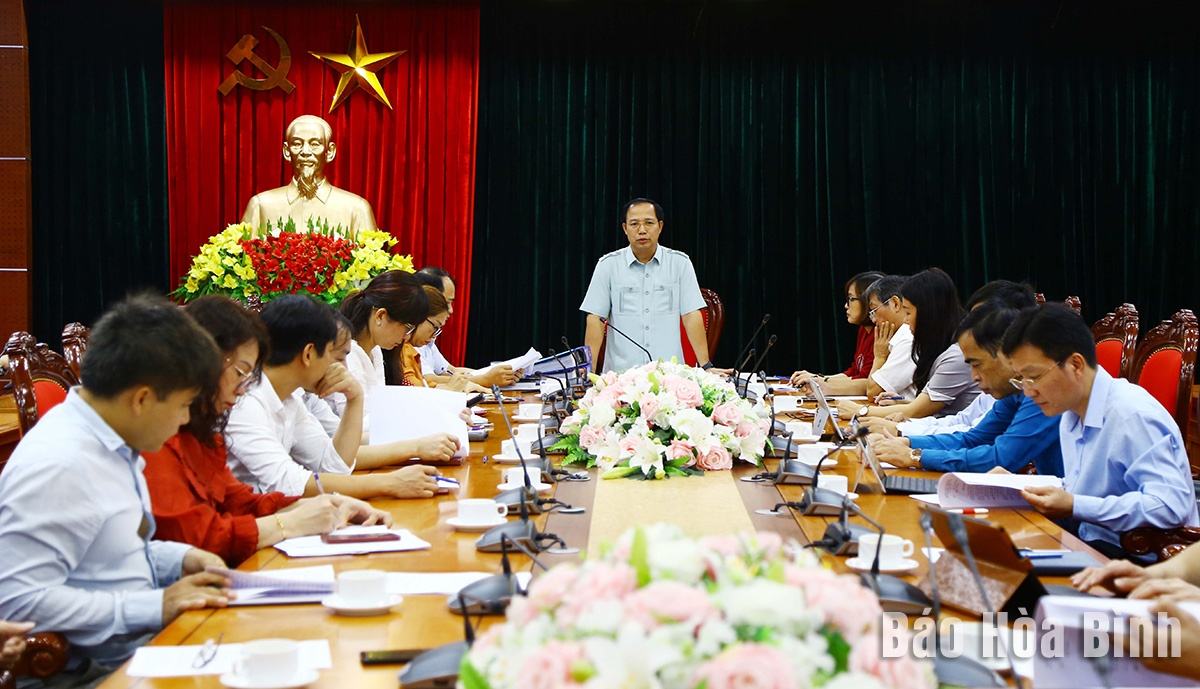
The People’s Committee of Hoa Binh held a meeting on November 9 to discuss the progress of the building of a national dossier on Mo Muong cultural heritage to submit to the UNESCO to seek the inclusion in the List of Intangible Cultural Heritage in Need of Urgent Safeguarding.
The meeting was chair by Nguyen Van Toan, Vice Chairman of the provincial People’s Committee and Standing Vice Chairman of the Steering Committee on the building of the national dossier on Mo Muong. It also drew leaders of the Music Institute under the Vietnam National Academy of Music (VNAM), the advisory agency of the project, and representatives from relevant agencies.
Nguyen Van Toan, Vice Chairman of the provincial People’s Committee, addresses the meeting.
Mo Muong is a job and also a performance practiced at funerals, religious festivals, and life cycle rituals by the Muong ethnic minority group. Mo Muong has a long life, spanning centuries, as it has always helped to nurture the characteristics and the souls of the Muong people. It is the essence of labour, production, cultural behaviour and the philosophy of the Muong people, reflecting their love of life and home villages.
According to a report by the Department of Culture, Sports and Tourism, so far all stép related to the building of the Mo Muong dossier have been implemented, including the formation of a steering committee, a committee for dossier building, along with the holding of surveys and seminars on Mo Muong, and meetings to discuss the plan and methods of building the national dossier on Mo Muong.
At the same time, the province has reviewed the inventory of Mo Muong heritage and collected commitments from the heritage-holding community. Ideas from researchers and heritage practitioners as well as culture management officials on the heritage have also been gathered, thus providing more information on the heritage for the building of a national dossier on the Mo Muong heritage. The province has also collected and recorded audio and video about Mo Muong cultural heritage, while organising international scientific conferences, compiling scientific documents, and conducting post-production documentary films about the heritage.
Participants at the meeting clarified steps to build the national dossier on Mo Muong to submit to the UNESCO, and analysed advantages and difficulties during the process.
Addressing the event, Nguyen Van Toan, Vice Chairman of the provincial People’s Committee, underlined that the compiling of the dossier requires the cooperation with other provinces and sees many difficulties. However, with the joint efforts of departments, sectors and agencies, so far the dossier has been basically completed and is being perfected.
Right after the meeting, sectors and agencies with assigned tasks should strengthen their collaboration to promptly complete and accept the dossier and submit it to relevant authorities in line with regulations, he asked.
With an increasingly vibrant and widespread emulation movement aimed at building cultured residential areas and cultured families, Yen Thuy District has been making steady progress toward improving both the material and spiritual well-being of its people, while fostering a civilized, prosperous, beautiful, and progressive community.
Once lacking recreational spaces and community facilities, Residential Group 2 in Quynh Lam Ward (Hoa Binh City) has recently received attention for the construction of a new, spacious, and fully equipped cultural house. The project followed the model of state support combined with public contributions in both labor and funding.
The "All people unite to build cultural life" movement, which has been effectively integrated with Kim Boi district’s socio-economic development goals, is fostering a lively spirit of emulation across local residential areas, hamlets, villages, public agencies, and enterprises. In addition, through the initiative, traditional cultural values are being preserved and promoted, while community solidarity and mutual support in poverty reduction and economic development are being strengthened.
A working delegation of the Hoa Binh provincial People’s Committee led by its Permanent Vice Chairman Nguyen Van Toan on June 11 inspected the progress of a project to build the Mo Muong Cultural Heritage Conservation Space linked to tourism services in Hop Phong commune, Cao Phong district.
Born and growing in the heroic land of Muong Dong, Dinh Thi Kieu Dung, a resident in Bo town of Kim Boi district, in her childhood was nurtured by the sweet lullabies of her grandmother and mother. These melodies deeply imprinted on her soul, becoming an inseparable part of her love for her ethnic group's culture. For over 20 years, this love for her hometown has driven Dung to research, collect, and pass down the cultural values of the Muong people to future generations.
In the final days of May, the Ethnic Art Troupe of Hoa Binh Province organized performances to serve the people in remote, mountainous, and particularly disadvantaged areas within the province. These were not just ordinary artistic shows, but they were the meaningful journeys aimed at spreading cultural values, enhancing the spiritual life of the people and contributing to the preservation of ethnic minority cultural identities.



